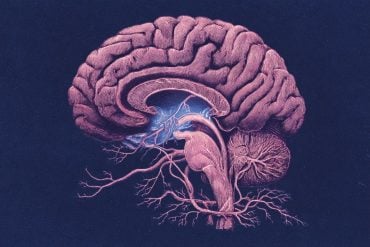Summary: Researchers made a significant breakthrough in treating phantom limb pain in lower-limb amputees.
Their study demonstrates how spinal cord stimulation, triggered by pressure sensors on a prosthetic foot, can restore sensation in the missing foot and significantly reduce phantom limb pain. This innovative approach not only alleviates chronic pain but also improves balance and gait stability in amputees.
Leveraging existing spinal cord stimulation technology, this research offers hope for over 1.5 million Americans living with lower-limb amputation, providing a viable solution for chronic pain and mobility issues.
Key Facts:
- Spinal cord stimulation in amputees can restore sensation in the missing foot and reduce phantom limb pain by 70%.
- The technology also improves balance and gait stability, addressing common mobility challenges in amputees.
- This approach leverages existing clinical technologies, making it more accessible and scalable for widespread use.
Source: University of Pittsburgh
Spinal cord stimulation can elicit sensation in the missing foot and alleviate phantom limb pain in people with lower limb amputations, University of Pittsburgh School of Medicine rehabilitation scientists report today.
Pressure sensors on the insole of a prosthetic foot triggered electrical pulses that were then delivered to a participants’ spinal cord. Researchers found that this sensory feedback also improved balance and gait stability.
The proof-of-concept study was done in collaboration with Carnegie Mellon University and University of Chicago researchers and reported in Nature Biomedical Engineering.
“We are using electrodes and stimulation devices that are already frequently used in the clinic and that physicians know how to implant,” said senior author Lee Fisher, Ph.D., associate professor of physical medicine and rehabilitation at Pitt.
“We are leveraging those technologies to produce meaningful improvement in function and reduction of pain. That’s exciting and we’ve been building it for a while.”
Among 1.5 million Americans who live with lower-limb amputation, 8 out of 10 experience some degree of chronic pain perceived as though coming from the missing leg or foot. This phantom limb pain often does not respond to pain medications and dramatically impairs the quality of life.
In addition, because even the most technically sophisticated prosthetics are not equipped with sensory feedback functionality, amputees remain prone to balance deficits and falls, which limit their mobility even further.
Unlike the typical stimulation system that works by shutting down pain neurons by overriding them with another sensory signal — similar to how rubbing your sore elbow helps relieve the pain — Fisher’s group leveraged the existing spinal cord stimulation technology to restore sensory feedback by replacing the severed connections between sensory neurons in the missing foot and the central nervous system.
To enable researchers to modulate the intensity of sensations in response to varying pressure on a prosthetic foot during walking, a pair of thin electrode strands implanted over the top of the spinal cord in the lower back was connected to a cell phone-sized stimulation device delivering electric pulses of varying amplitude and frequency. The leads were implanted for one to three months and removed after the trial ended, in accordance with the study design.
Unlike previous research done by other groups, Fisher and team were able to exert active control of spinal cord stimulation parameters to control stimulation in real-time while subjects engaged their prosthetic leg to stand or walk.
In addition to clinically meaningful improvement in balance control and gait even in the most challenging conditions, such as standing on a moving platform with eyes closed, participants reported an average 70% reduction in phantom limb pain — a highly meaningful outcome given the lack of clinically available treatment options.
The beauty of this technology lies in its versatility: the pilot study showed that it can work in people with extensive peripheral nerve damage due to chronic conditions, such as diabetes, or in people with traumatic amputations. It also doesn’t require costly custom-made electrodes or uncommon surgical procedures, making it easier to scale up on a national level.
“We are able to produce sensations as long as the spinal cord is intact,” said Fisher. “Our approach has the potential to become an important intervention for lower-limb amputation and, with proper support from industry partners, translated into the clinic in the next five years.”
Other authors of this study are Ameya Nanivadekar, Ph.D., Rohit Bose, B.S., Bailey Petersen, D.P.T., Ph.D., Tyler Madonna, B.S., Beatrice Barra, Ph.D., Isaiah Levy, M.D., Eric Helm, M.D., Vincent Miele, M.D., Michael Boninger, M.D., and Marco Capogrosso, Ph.D., all of Pitt; Devapratim Sarma, Ph.D., Juhi Farooqui, B.S., Ashley Dalrymple, Ph.D., and Douglas Weber, Ph.D., all of Carnegie Mellon University; and Elizaveta Okorokova, Ph.D., and Sliman Bensmaia, Ph.D., of the University of Chicago.
About this neurotech research news
Author: Anastasia Gorelova
Source: University of Pittsburgh
Contact: Anastasia Gorelova – University of Pittsburgh
Image: The image is credited to Neuroscience News
Original Research: Closed access.
“Restoration of sensory feedback from the foot and reduction of phantom limb pain via closed-loop spinal cord stimulation” by Lee Fisher et al. Nature Biomedical Engineering
Abstract
Restoration of sensory feedback from the foot and reduction of phantom limb pain via closed-loop spinal cord stimulation
Restoring somatosensory feedback in individuals with lower-limb amputations would reduce the risk of falls and alleviate phantom limb pain.
Here we show, in three individuals with transtibial amputation (one traumatic and two owing to diabetic peripheral neuropathy), that sensations from the missing foot, with control over their location and intensity, can be evoked via lateral lumbosacral spinal cord stimulation with commercially available electrodes and by modulating the intensity of stimulation in real time on the basis of signals from a wireless pressure-sensitive shoe insole.
The restored somatosensation via closed-loop stimulation improved balance control (with a 19-point improvement in the composite score of the Sensory Organization Test in one individual) and gait stability (with a 5-point improvement in the Functional Gait Assessment in one individual).
And over the implantation period of the stimulation leads, the three individuals experienced a clinically meaningful decrease in phantom limb pain (with an average reduction of nearly 70% on a visual analogue scale).
Our findings support the further clinical assessment of lower-limb neuroprostheses providing somatosensory feedback.







